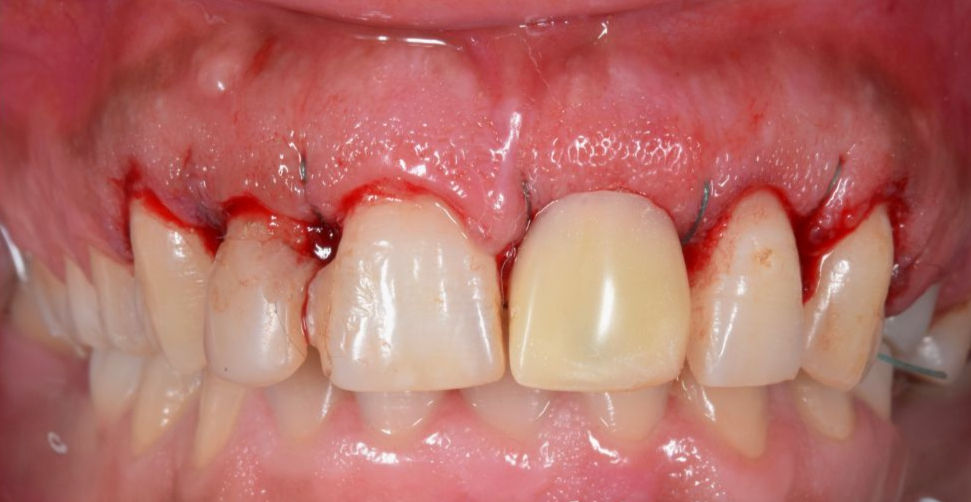Gum Disease: Causes, Symptoms & Effective Treatment Options
- mubeendesg
- Feb 19
- 3 min read
Updated: Mar 27
1. What is gum disease?
For teeth to remain strong, the gums around the teeth and the bone beneath them must be healthy. If they become unhealthy, the gums may develop disease, leading to weak and loose teeth—this condition is known as gum disease. Approximately 80% of the Indian population is affected by gum disease.
2. What causes gum disease?
Gum disease can be caused by several factors, including:
Plaque and calculus (tartar) buildup around the teeth
Hereditary factors (genetic predisposition)
Misaligned teeth (malalignment)
Systemic diseases like diabetes
Antiepileptic medications
Smoking or tobacco use
Hormonal changes during pregnancy and childbirth
Autoimmune diseases

3. What are the symptoms of gum disease?
Common signs and symptoms of gum disease include:
Bad breath (halitosis)
Bleeding gums (especially while brushing or flossing)
Calculus (tartar) around the teeth
Pain or swelling in the gums
Gum recession (gums pulling away from the teeth)
Gaps or spacing between teeth
Toothache
Loose or weakened teeth
Silent symptoms – Some people may have gum disease without any visible signs
4. What are the stages of gum disease?
Gum disease progresses in two main stages:
Gingivitis – The first stage of gum disease, characterized by inflammation and bleeding. At this stage, the condition is easily treatable and reversible.
Periodontitis – The advanced stage of gum disease. This affects the bone supporting the teeth, causing severe damage if left untreated.


5. How does gum disease develop?
Gum disease begins with plaque and calculus forming around the teeth. This leads to:
Gum irritation – Causes swelling and bleeding.
Pocket formation – Untreated gum inflammation causes the gum to separate from the tooth, forming pockets where food and bacteria collect.
Bone damage – As the disease progresses, the infection damages the bone, causing the teeth to become loose.
Tooth loss – In severe cases, irreversible damage can lead to tooth loss.
6. What are the treatments for gum disease?
Treatment options vary based on the severity of the disease:
Scaling – Removes plaque and calculus from the teeth.
Gingival Curettage – Deep cleaning of the gums to remove infected tissue.
Flap Surgery – A surgical procedure to clean deeper pockets, reshape damaged bone, and help the gums reattach to the teeth.
These treatments prevent further damage and restore gum health.

7. What happens if gum disease is not treated?
Untreated gum disease can lead to:
Weak and loose teeth, making it difficult to chew properly and causing digestive issues.
Tooth loss, requiring artificial tooth replacement.
Systemic health risks – Oral bacteria can enter the bloodstream and affect other organs like the heart, kidneys, joints, and skin (a condition known as Focal Sepsis).
Regular dental care is essential to prevent these complications.
8. How can gum disease be prevented?
Early detection and proper oral care can prevent gum disease. Follow these steps:
Regular dental check-ups – Visit your dentist to detect gum disease early.
Professional cleaning – Even with good brushing habits, plaque can accumulate in hard-to-reach areas.
Healthy habits – Maintain proper oral hygiene and seek timely treatment if needed.
9. Tips to prevent gum disease:
✅ Get your teeth professionally cleaned once a year.
✅ Brush twice daily using fluoride toothpaste.
✅ Massage your gums regularly.
✅ Use interdental brushes, dental floss, and mouthwash as recommended by your dentist.
10. Common Myths about Gum Disease Treatment:
❌ Myth: Cleaning weakens the enamel.
✔ Fact: Scaling removes plaque and tartar without damaging enamel.
❌ Myth: Cleaning creates gaps between teeth.
✔ Fact: The gaps are caused by plaque buildup, which cleaning removes to restore natural spacing.
❌ Myth: Cleaning causes itching.
✔ Fact: Proper cleaning reduces gum inflammation, which may cause temporary sensitivity but not itching.
❌ Myth: Cleaning makes teeth loose.
✔ Fact: Cleaning removes harmful deposits, helping to prevent tooth mobility, not cause it.





Comments